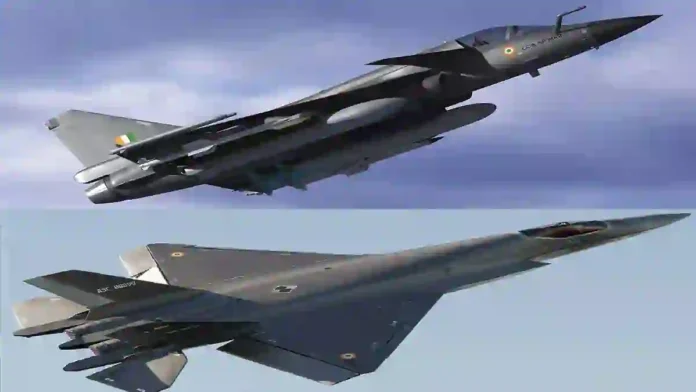India is building a comprehensive indigenous fighter ecosystem centred around the TEJAS MK-2 and the Advanced Medium Combat Aircraft (AMCA), aimed at achieving strategic autonomy and strengthening its aerospace industry. The TEJAS MK-2, classified as a 4.5-generation medium-weight multi-role fighter, is designed to fill the gap between the light TEJAS MK-1A and heavier twin-engine fighters like the Rafale.
It is intended to replace ageing fleets of Mirage-2000, MiG‑29, and Jaguar aircraft in the Indian Air Force (IAF), thereby maintaining squadron strength while providing a domestically produced multi-role platform capable of air superiority and ground strike missions.
Read- 6 Made In India Technologies Going Into TEJAS MK-2 Fighter Jet
The TEJAS MK-2 incorporates an elongated airframe, close-coupled canards, indigenous weapons, and modern avionics, powered by the GE F414 engine with 82% indigenous content initially, expected to reach over 90% after licensed engine production.
The AMCA is India’s planned fifth-generation stealth fighter, developed by the Aeronautical Development Agency (ADA) and Hindustan Aeronautics Limited (HAL). It is a 25-ton, twin-engine multi-role stealth aircraft designed to feature advanced characteristics such as stealth shaping, internal weapons bays, super-cruise capability, advanced sensor fusion, electronic warfare suites, and AI-assisted avionics.
The AMCA aims to excel in air superiority, deep strike, electronic warfare, and suppression of enemy air defences, forming the high-end strategic asset complementing the TEJAS MK-2 within the IAF.
The program has recently entered its execution phase with approval for five prototype developments slated for completion by around 2035, intending to replace older aircraft like the Sukhoi Su-30MKI over time.
Both TEJAS MK-2 and AMCA share several indigenous technologies, including the Uttam AESA radar, electronic warfare suites, avionics, and smart weapon integration. The GE F414 engine powering the TEJAS MK-2 also serves as the technological foundation for the AMCA’s MK-1 prototype engines, enabling technology continuity and easier industrial scaling.
There is further active exploration of partnerships, notably with the French company Safran, to develop more advanced engines for both platforms to enhance performance, payload, and endurance, which would support domestic engine manufacturing and reduce reliance on US supply.
Read- Why India Fell Behind in Getting Enough Fighter Jets?
Read- No F-35 Formal Fighter Jets Discussions With US: Centre To Lok Sabha
The simultaneous development of these two aircraft supports the growth of a sustained domestic aerospace production ecosystem involving HAL, DRDO, and private suppliers.
This ecosystem focuses on manufacturing radars, sensors, flight control systems, and weapons indigenously, thereby decreasing import dependence and building competencies potentially extendable to future sixth-generation fighter designs.
Strategically, the combination of the TEJAS MK-2 as a high-volume workhorse and the AMCA as an advanced stealth platform ensures India maintains robust squadron numbers and enhances air combat readiness through the 2030s and beyond.
The integration of advanced AI capabilities from AMCA into the TEJAS MK-2 is set to enhance pilot efficiency and operational synergy, creating a networked combat ecosystem where both aircraft operate complementarily in complex scenarios.
This indigenous ecosystem not only ensures strategic autonomy in defence procurement but also significantly boosts India’s fighter export potential by offering both medium-weight and stealth platforms to partner nations in Asia, Africa, and South America without dependence on foreign OEMs.
In short, the TEJAS MK-2 and AMCA together represent a layered Indian fighter ecosystem spanning 4.5-generation to fifth-generation technologies, aimed at replacing multiple legacy fleets, sustaining squadron readiness, fostering self-reliance, and positioning India as a key aerospace and defence exporter.
Based On WION Report
Agency




